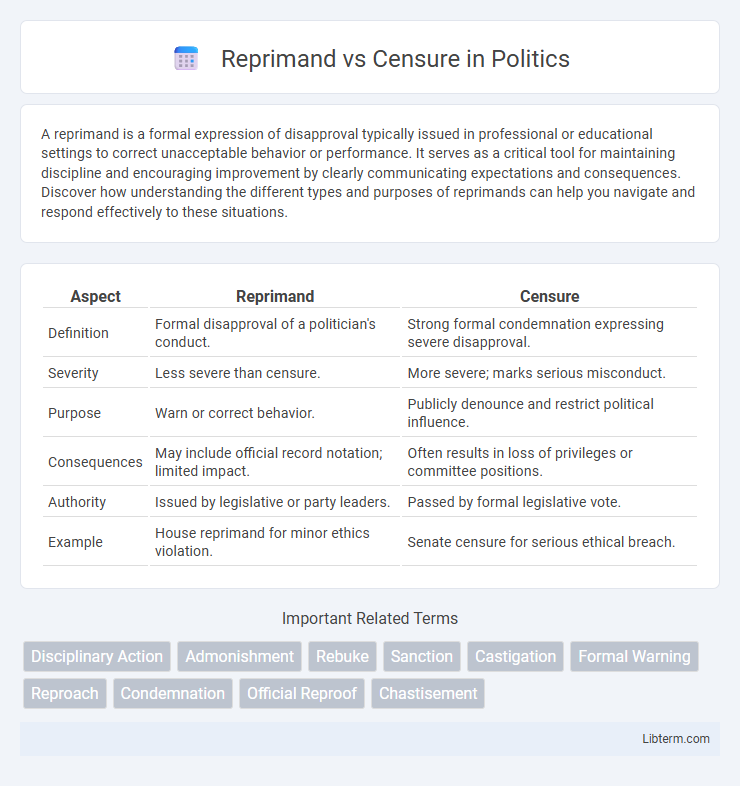A reprimand is a formal expression of disapproval typically issued in professional or educational settings to correct unacceptable behavior or performance. It serves as a critical tool for maintaining discipline and encouraging improvement by clearly communicating expectations and consequences. Discover how understanding the different types and purposes of reprimands can help you navigate and respond effectively to these situations.
Table of Comparison
| Aspect | Reprimand | Censure |
|---|---|---|
| Definition | Formal disapproval of a politician's conduct. | Strong formal condemnation expressing severe disapproval. |
| Severity | Less severe than censure. | More severe; marks serious misconduct. |
| Purpose | Warn or correct behavior. | Publicly denounce and restrict political influence. |
| Consequences | May include official record notation; limited impact. | Often results in loss of privileges or committee positions. |
| Authority | Issued by legislative or party leaders. | Passed by formal legislative vote. |
| Example | House reprimand for minor ethics violation. | Senate censure for serious ethical breach. |
Understanding Reprimand and Censure
Reprimand and censure both serve as formal expressions of disapproval but differ in severity and context. A reprimand is typically a private or less formal rebuke issued within organizations to address minor misconduct or performance issues, aiming to correct behavior. Censure, on the other hand, is a more severe and public condemnation often used by legislative bodies or professional associations to formally denounce significant wrongdoing or ethical violations.
Legal Definitions of Reprimand vs Censure
A reprimand is a formal expression of disapproval issued by an authority, often documented in an individual's professional or legal record but usually less severe and sometimes confidential. Censure, in contrast, is an official public statement of condemnation or disapproval, typically issued by legislative bodies or professional organizations, carrying greater weight and more significant consequences. Both serve as disciplinary measures, but censure often implies a stronger denouncement and can impact reputation and career more substantially than a reprimand.
Historical Context of Reprimand and Censure
Reprimand and censure have distinct historical roots in legal and political settings, with reprimand originating as a formal expression of disapproval within military and legal frameworks dating back to medieval Europe. Censure evolved primarily in parliamentary practice, notably in the British Parliament during the 17th century, as a formal public condemnation of a member's conduct. Both terms reflect evolving mechanisms of accountability but differ in severity and procedural use across history.
Key Differences Between Reprimand and Censure
Reprimand and censure differ primarily in severity and formality; a reprimand is a formal expression of disapproval typically issued privately within an organization, while censure is a more serious, public condemnation often used by legislative or governing bodies. Reprimands usually serve as corrective measures to address minor misconduct, whereas censures are reserved for significant breaches of conduct or ethical violations. The impact of censure is more damaging to reputation and may carry formal consequences beyond the immediate rebuke associated with reprimands.
Common Scenarios for Issuing Reprimands
Reprimands are commonly issued in workplace settings for violations such as tardiness, policy breaches, or failure to meet performance standards. In educational institutions, reprimands address student misconduct like cheating or disruptive behavior. These situations typically involve formal documentation to correct behavior without imposing severe penalties, distinguishing reprimands from the more formal and public nature of censures.
When Is Censure More Appropriate?
Censure is more appropriate when a formal, public statement of disapproval is necessary to address misconduct without imposing legal penalties, often used in political, organizational, or legislative contexts. It serves as a clear record of condemnation by a governing body, highlighting serious ethical violations or breaches of conduct that require accountability but not removal from office or position. Unlike reprimand, which is typically private and less severe, censure carries significant reputational consequences and is documented in official proceedings.
Impact of Reprimand vs Censure on Careers
Reprimand and censure both serve as formal expressions of disapproval but differ in severity and career impact; a reprimand is a less severe, often confidential warning that may not significantly hinder professional advancement. In contrast, a censure is a public condemnation that can damage reputation, limit promotion opportunities, and create lasting barriers in career growth. Understanding the distinctions helps individuals navigate workplace consequences and strategize reputation management effectively.
Reprimand and Censure in Professional Settings
Reprimand and censure are formal disciplinary actions used in professional settings to address misconduct or policy violations. A reprimand typically involves a direct, written or verbal warning issued to an employee, emphasizing corrective behavior without public disclosure, while censure is a stronger, often public expression of disapproval that may appear in official records or impact professional reputation. Organizations use reprimands for minor infractions and censures for more serious violations, both aiming to maintain workplace standards and accountability.
Public Perception: Reprimand vs Censure
Reprimand and censure differ significantly in public perception, with censure viewed as a more formal and severe condemnation that often attracts wider media attention and public scrutiny. Reprimand is typically perceived as a private or internal disciplinary action with limited impact on reputation. The public often associates censure with a loss of credibility and trust, while a reprimand may be seen as a lesser or corrective measure.
Best Practices for Addressing Misconduct
Effective best practices for addressing misconduct emphasize clear differentiation between reprimand and censure, where reprimand serves as a formal warning or expression of disapproval, often documented in personnel files, while censure is a stronger, public condemnation typically used in organizational or governmental contexts. Implementing a structured process involving thorough investigation, consistent application of policies, and clear communication ensures fairness and accountability during disciplinary actions. Documenting outcomes and providing opportunities for remediation or training can help prevent recurrence and support organizational integrity.
Reprimand Infographic

 libterm.com
libterm.com